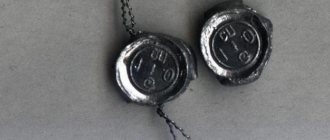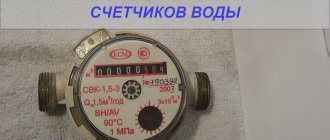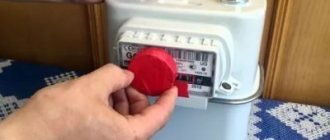Such seals are used in gas, water and electricity meters to prevent attempts to change their readings (for example, unwinding).
Are there ways to remove such devices?
To remove the rotor seal you will need oil. It is applied to the fastening element and the place where it is in direct contact with the seal, after which you can try to pull the body (together with the locking insert) off the wire. In this case, the efforts made must be precisely adjusted, because you can easily break the wire.
If the above method does not work, then it is suggested to place the product in hot (but not too hot) water, after which you can try again.
To reuse an already removed seal, a new wire is needed, the ends of which are pushed into the body with a needle and then tied with a knot.
We do not advise you to carry out the above-described manipulations, because installing the product back is an almost impossible task. You won’t be able to put another seal in place of the old one either: each of them is marked with an individual number. This number must be entered in the accounting journal.
What to do if you accidentally damage a rotor seal?
You should notify the service that installed the product as soon as possible. Very often, after this, the metering device is removed for inspection. If you did not perform any manipulations with the meter, then they will simply install a new seal for you and register it in the journal. At the same time, failure to timely notify about a damaged seal or establish the fact of a change in your meter readings will result in a fine.
How to remove a rotor seal?
The rotary seal is a monolithic structure made of thin wire and a transparent seal body. The mechanism is designed in such a way that once the seal is closed, it can no longer be opened. The wire is very fragile and breaks when bent.
Rotary seals are used on electricity, gas, and water meters. They are used to prevent the impact on counters - unwinding indicators, etc.
So is it possible to remove a rotor seal?
One way is to use machine oil. It lubricates the wire and the place where the wire comes into contact with the seal. After this, you can try to pull the seal off the wire. It is necessary to control the efforts, since the wire is extremely fragile.
If the seal cannot be removed, you should place it in a container of hot water for a few minutes. It is important that the water is not boiling or too hot.
After hot water, the seal should be easy to remove.
In order to return the rotor seal “in place”, a new piece of wire is used. Using a needle, the ends of the wire need to be pushed through the seal. After which, the ends of the wire or cord must be tied in a knot.
However, if the seal cannot be returned to its place, you must report the damage to the housing office. For opening the seal and late reporting of its damage, an administrative fine is provided. In addition, most likely, your counter will be taken for inspection and it may be revealed that the indicators have been rolled back.
All seals are numbered and individual. Information about them is recorded in a special journal. That is why it is impossible to remove and then put on another rotor seal.
That is why we do not recommend that you remove the rotor seal from water and electricity meters. It is almost impossible to hide an attempt to interfere, even if it fails. But it’s easy to get yourself into trouble. It may turn out that penalties will cost you more than paying your real bills.
It happens that the rotor seal was damaged accidentally, without the intention of manipulating the meters, for example, during repairs. In this case, you should immediately report the damage to the seal in order to avoid troubles and fines. In this case, you will most likely get off with a verbal warning.
© 2010-2019 ASPLOMB-Ural
Ekaterinburg
, st.
Mashinnaya, 29b, office 419 Chelyabinsk
, st.
Kuibysheva, 17a Perm
, Promyshlennaya st., 84b, office 102
A water meter is a small device that is mounted in a cold or hot water supply pipe and shows the consumption of cubic meters. You can install it yourself or call a plumber, but a seal is necessary in any case; you need a special sealing inspector.
Features and types of meters
The main type of household meters is tachometer; the principle of its operation is simple: the pressure of water passing through a pipe turns the impeller blades, like a fan. A system of gears transmits torque to the counter itself, the last disk with numbers scrolls through the cycle and moves the next disk one division, which repeats the first, but counts in tens rather than units.
The device of the meter, which collects cubic meters of water, is simple and similar to electric meters. The mechanism of the tachometer device is isolated from the flow of water, which is why it is also called dry-running or dry. The display system consists of five rollers, which display, through a mechanical scaling gear, the flowing volume of water, measured in cubic meters.
What errors can occur when parsing the counter?
There are expensive, high-quality meters that, even after the end of the service life declared by the manufacturer, are in good condition and are quite suitable for work after replacing some particularly worn parts. Then you can disassemble the structure, replace parts and, calling a specialist, start it up again. It is better, of course, to replace the meters themselves with new ones, because you will still have to pay for registration and verification.
When disassembling the upper part, it is better to use a screwdriver more carefully; the parts are very fragile and break easily, especially the bottom adjacent to the water chamber.
It’s good to call the water utility and warn them about any changes, provide current readings. Because if you take it apart, then it will be very difficult to challenge the fact that the meter is twisted back. Also, there is no point in disassembling the upper part at all, besides, if the gears fall out, assembling and inserting them back correctly will be a painstaking task.
If it is necessary to disassemble the lower part, then in the event of further operation, you need to act extremely carefully, since any mistakes will lead to leakage.
A rotary seal is a multi-component structure consisting of a plastic body, a polycarbonate insert and a wire fastening element. The design of the product does not allow the seal to be opened after sealing: the thin wire of the fastening element breaks off when trying to bend it.
Such seals are used in gas, water and electricity meters to prevent attempts to change their readings (for example, unwinding).
Are there ways to remove such devices?
To remove the rotor seal you will need oil. It is applied to the fastening element and the place where it is in direct contact with the seal, after which you can try to pull the body (together with the locking insert) off the wire. In this case, the efforts made must be precisely adjusted, because you can easily break the wire.
If the above method does not work, then it is suggested to place the product in hot (but not too hot) water, after which you can try again.
To reuse an already removed seal, a new wire is needed, the ends of which are pushed into the body with a needle and then tied with a knot.
We do not advise you to carry out the above-described manipulations, because installing the product back is an almost impossible task. You won’t be able to put another seal in place of the old one either: each of them is marked with an individual number. This number must be entered in the accounting journal.
What to do if you accidentally damage a rotor seal?
You should notify the service that installed the product as soon as possible. Very often, after this, the metering device is removed for inspection. If you did not perform any manipulations with the meter, then they will simply install a new seal for you and register it in the journal. At the same time, failure to timely notify about a damaged seal or establish the fact of a change in your meter readings will result in a fine.
Types of fillings
Depending on which organization installed the protection, the following types of sealing are distinguished:
- factory - installed by the manufacturer to prevent the device from being opened;
- utility companies - used by representatives of electricity suppliers to protect against theft of resources by the owner.
In most cases, the owner does not need to remove factory seals. Most often, it is necessary to temporarily remove the protection of a utility organization. Electricity suppliers use the following types of seals:
- lead - in the form of a washer made of this material, compressed on a wire connection passed through the terminal compartment cover through brackets specially equipped for this purpose;
- plastic - equipped with individual numbers and installed similarly to lead;
- clamps - in the form of a one-sided plastic device;
- sealing stickers, including antimagnetic ones, designed to prevent the meter from being affected by a neodymium magnet. They are glued after removing the protective film from the surface on which the adhesive layer is applied.
We recommend: How to check and what to do if the electric meter winds up more than used
The first ones listed are the most common. For installation, a special sealer is used, which, after compression, leaves an impression with an individual designation.
A bit of bureaucracy
Before removing the water meter yourself, you need to call a representative from the city water supply service so that he can take readings from the device and open the seal. To do this, it is necessary to prepare the entire package of documents so that the representative writes down all the data in the register. And for this you need to have:
- passport data so that the representative can make sure that the water meter is being changed by the owner of the house and not by a stranger;
- registration certificate for the water meter (if you need to remove devices for cold and hot water, then you need to provide two registration certificates for each device);
- telephone number (if the number entered in the register has been changed).
When the representative checks all the documents and agrees with the owner of the house on the reason why the meter should be changed, the owner can begin work.
A representative of the water utility or another company that is licensed to install the meter must be called in any case. Because, as already mentioned, this device is state property. And, if the seal was damaged during the process, then the owner may simply be fined.
But, before changing the meter, you need to decide why it needs to be done. And depending on the problem, go in the right direction. So, before you remove the water meter yourself, you need to know that water meters are removed in case of the following problems.
- The service life of the water meter has expired.
- The device broke down before its warranty expired.
- The control valve is broken.
- Physical damage to the water meter.
- Replacement of pipes in the water supply system.
- In case of exchange or sale of housing.
Therefore, depending on the problem, it is necessary to solve and coordinate all work with the representative. Because for some types of work you will have to turn off the water supply to the entire riser. And this point needs to be discussed with neighbors in advance. After all, few people would like not having water during the day.
Preparatory work
After all the bureaucratic details are completed, you can start working. And to do this you need to familiarize yourself with the plumbing unit, which usually consists of:
- control valve;
- coarse filter;
- a check valve that allows water to flow in only one direction;
- the counter itself;
- devices that are included in the bathroom system after the water meter.
In order to remove the water meter, you will need tools with which to dismantle:
- an adjustable wrench (or a set of wrenches to fit the size of the nuts);
- a caliper or other measuring instrument (for example, a ruler);
- hard brush for metal;
- stationery or construction knife;
- flat head screwdriver;
- rubber hose, or metal insert, with a diameter of 9 - 18 mm. in radius and length 110 mm;
- fittings (9 – 18 mm diameter) for the hose, or sealing tape for the metal insert;
- clamps (for hose) (20 mm radius);
- rubber gaskets (3/4), but they can be replaced with paronite.
First you need to close the control valve. It happens that the reason for dismantling the meter is precisely a broken control valve, which is located close to the device. And to do this you need to block the entire riser. But if this is not the problem, then it is enough to use a key (if there is no handle) or turn off the water supply by hand.
Then you need to completely drain the water from the pipe that comes after the meter, and then you need to make sure that the water is completely shut off. The dirt filter is not often cleaned, so you need to take a metal brush, after removing the filter, and carefully, but with pressure on the surface, remove the deposits. Then you need to rinse the filter under running water. To do this, you need to open the control valve for a while.
You can use a hose and bucket to avoid flooding your neighbors. The next step is to loosen the two union nuts of the water meter. And to do this, you need to hold the base of the union nut with one key and unscrew the nut itself with another key. The nuts are unscrewed one by one until the end. When the nuts are unscrewed, you need to remove the meter and pull out the old gaskets.
If the meter was installed recently and the gaskets did not have time to dry out, then they can be put back later, but experts recommend replacing them in any case. Next you need to install an adapter either from a rubber hose or from a metal tube. The method depends on taste preferences and how long the water meter will be out.
The adapter is made from a rubber hose as follows. The measuring device takes measurements of the meter (its maximum width). Next you need to measure the length of the fitting (there are 2 of them) and then you need to measure the required length of the tube. To do this, use the formula (meter width – (nozzle length x 2)).
The required length of the rubber tube must be cut with a knife and pulled one end onto one fitting until it stops. Then you need to put two clamps on the hose and thread the tube into the second fitting. The clamps are tightened at both ends of the tube with a screwdriver. That's it - the adapter is ready
Removing a filling from a tooth: indications
Filling is one of the most common types of prosthetics, with which you can restore a small area of a tooth (in case of extensive damage to the dental material, another type of prosthetics, for example, crowns, is often prescribed). The filling is designed to protect the dental material from further destruction and infection from entering the pulp, as well as to restore the functionality and appearance of the damaged tooth. Depending on the material, fillings can last from 2 to 15 years, but with proper care, a filling made from quality materials can last longer.
The reason for replacing the filling may be:
- darkening of the filling - the color of the filling changes due to the formation of microcracks in the material;
- chipping of part of the filling - this can happen due to the low strength of the material or an excess of solid foods in the diet that violate the integrity of the filling;
- blackening of the area of the tooth under the filling - a change in the color of the tooth indicates the development of caries under the filling, which can cause the tooth to completely collapse;
- deformation of the filling - grinding and abrasion of the material, due to which the edges of the filling can injure surrounding tissues.
When the old filling can no longer perform its function, it needs to be replaced.
How to remove a water meter without damaging the seal
Sometimes you need to remove the meter, and it can be very expensive to wait for a specialist to remove the seal. Many experts answer this question ambiguously. Firstly, removing the filling is a very important moment. And if it is even accidentally torn off, the owner will still be fined. But when time is running out, and repair work can be done without damaging the filling, then you need to be patient and discover the talents of a jeweler in yourself.
The water meter can be removed without damaging the seal in two ways:
- A piece of pipe is removed along with the meter. This is if the design allows and the seal does not extend to the section of the pipe that needs to be removed.
- You need to remove the pipe that fits tightly to the meter. In this case, the pipe that is connected to the meter is removed, but the seal should not pass through it.
The meter can be removed without damaging the seal, but to do this it should not pass through the eyelet, which is located on the removable pipe. But, if the problem lies in the meter itself, then there is no way to avoid damaging the seal.
Even if there is a chance to remove the water meter without damaging the seal, this must be done very carefully. To do this you need to have a very fine jewelry sense. Therefore, you need to call another person to be on the safe side, or do several operations yourself at the same time.
Methods of legalization
The problem of reinstalling a broken seal and legalizing it is solved very simply. Today there are several proven options for how to do this.
Ways to legalize a broken seal:
- In a situation where the values of the meter readings and the numbers in the last receipt are approximately the same, you can simply call the service organization;
- If the readings on the device and the latest data differ greatly, this can lead to a change in the order of electricity calculations from actual to theoretical, which is quite unprofitable;
- Contact the energy service with a statement that the seal was broken due to theft, while recording the date and time of the incident.
In some situations, it will be enough just to leave a verbal telephone statement that repair work is planned and that after this it will be necessary to re-install the seal.
To legally remove the seal from a gas meter, you should call a specialist
The appeal must contain information that the owner of the device intends to break the seal, and after completing the repair work, he undertakes to call specialists to replace it.
If more serious work is planned or there is a large debt to the utility service, then a personal visit to the organization may be required.
How can you remove the meter yourself for verification?
As already mentioned, water meters are state property. And all this should be done either by the city water utility or by companies that have a license for this. Therefore, even if you are the most wonderful master and can remove the meter in five minutes, then it can take a very long time to go through all these bureaucratic authorities. Therefore, before removing the device for verification, you need to:
- invite a specialist from a company that is licensed to remove and install seals;
- the company is obliged to have warranty service, as well as the availability of spare parts and licensed meters in case of breakdown of the installed equipment;
- all necessary documents that have legal force (with all signatures and seals).
If the owner of the water meter decides to install it himself, then he is required to invite a specialist to remove the seal, enter the data into the register and, after the installation work has been carried out, put the seal in place. But, at the same time, the representative must check whether the device is installed correctly. And if he decides that it was installed incorrectly, the owner will have to redo the job until the representative approves the work and places a new seal, which will be entered into the register.
If the owner invites a specialist to not only remove and install the seal, but also take the water meter for verification, in this case, the company is fully responsible for the quality of the work done. That is, the owner of the water meter is simply not concerned with the nuances. The specialist came, completed all the documents, removed the seal himself, removed the water meter, installed the adapter and took it for verification and gave a receipt for payment (if necessary). When the verification was completed, the same specialist called the owner of the house, came, installed the meter, received all the necessary signatures, took a copy of the paid receipt and left. Therefore, what the water meter owner should do is up to him to decide.
Refusal of a water meter
How to refuse water meters? There are few such owners. Moreover, at the moment it is much more profitable to pay for water using a meter than at a general tariff. But if such citizens meet, then a government agency can carry out such a procedure. And for this you need to go to the city water utility and conclude a new agreement.
After this, a specialist comes to the apartment, writes down the latest meter readings and enters all the data into the register. Then he breaks the seal and the area with the device is replaced with a metal adapter (as described earlier). That’s it – the procedure is completed, and the apartment owner now pays the general tariff. It should be added that this procedure is also available for hot water. This method exists, but it is best to obtain receipts based on water readings. It's much cheaper.










